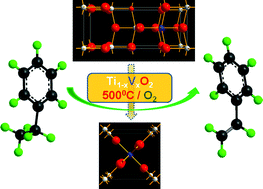Molecular oxygen-assisted oxidative dehydrogenation of ethylbenzene to styrene with nanocrystalline Ti1−xVxO2
Abstract
Oxidative

* Corresponding authors
a
Catalysis Division, National Chemical Laboratory, Dr Homi Bhabha Road, Pune, India
E-mail:
cs.gopinath@ncl.res.in
Web: http://www.ncl.org.in/csgopinath
Fax: +91-20-2590 2633
Tel: +91-20-2590 2043
b Centre of Excellence on Surface Science, National Chemical Laboratory, Dr Homi Bhabha Road, Pune, India
Oxidative

 Please wait while we load your content...
Something went wrong. Try again?
Please wait while we load your content...
Something went wrong. Try again?
K. Sivaranjani, A. Verma and C. S. Gopinath, Green Chem., 2012, 14, 461 DOI: 10.1039/C1GC15907K
To request permission to reproduce material from this article, please go to the Copyright Clearance Center request page.
If you are an author contributing to an RSC publication, you do not need to request permission provided correct acknowledgement is given.
If you are the author of this article, you do not need to request permission to reproduce figures and diagrams provided correct acknowledgement is given. If you want to reproduce the whole article in a third-party publication (excluding your thesis/dissertation for which permission is not required) please go to the Copyright Clearance Center request page.
Read more about how to correctly acknowledge RSC content.
 Fetching data from CrossRef.
Fetching data from CrossRef.
This may take some time to load.
Loading related content
